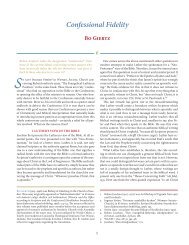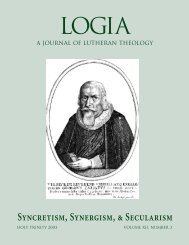The Lord's Supper in the Theology of Martin Chemnitz Bjarne - Logia
The Lord's Supper in the Theology of Martin Chemnitz Bjarne - Logia
The Lord's Supper in the Theology of Martin Chemnitz Bjarne - Logia
You also want an ePaper? Increase the reach of your titles
YUMPU automatically turns print PDFs into web optimized ePapers that Google loves.
<strong>The</strong> Consecration |<br />
Verba. <strong>Chemnitz</strong>, however, observes that perhaps “someone says that a person eats bread<br />
unworthily. <strong>The</strong> answer is: Paul does not refer simply to bread, but he says ‘this bread.’<br />
But what bread is this? It is <strong>the</strong> bread which accord<strong>in</strong>g to <strong>the</strong> Word <strong>of</strong> Institution is <strong>the</strong> body<br />
<strong>of</strong> <strong>the</strong> Lord given for us” (LS 131, emphasis added). A few paragraphs later <strong>Chemnitz</strong> aga<strong>in</strong><br />
emphasizes <strong>the</strong> po<strong>in</strong>t by ask<strong>in</strong>g what bread is it that one eats that <strong>in</strong>curs guilt, “But what<br />
bread? <strong>The</strong> bread which Christ affirms is His body” (LS 132). All <strong>the</strong> elements that came<br />
under <strong>the</strong> words <strong>of</strong> Christ at <strong>the</strong> consecration are His body and blood. And hence it is by<br />
partak<strong>in</strong>g <strong>of</strong> those particular elements that one may eat unworthily and become guilty <strong>of</strong><br />
<strong>the</strong> body and blood <strong>of</strong> Christ.<br />
75. <strong>The</strong> translation <strong>in</strong> <strong>the</strong> Tappert edition <strong>of</strong> <strong>the</strong> Book <strong>of</strong> Concord is mislead<strong>in</strong>g,“It was aga<strong>in</strong>st<br />
such papistic abuses that this rule was first formulated and expla<strong>in</strong>ed by Dr. Lu<strong>the</strong>r.” <strong>The</strong><br />
translation seems to say that Lu<strong>the</strong>r not only expla<strong>in</strong>ed <strong>the</strong> rule but first formulated it. <strong>The</strong><br />
German and Lat<strong>in</strong> versions only say that <strong>the</strong> rule was orig<strong>in</strong>ally established, and that <strong>the</strong><br />
reference to Lu<strong>the</strong>r is only <strong>in</strong> connection with <strong>the</strong> word” expla<strong>in</strong>.” <strong>The</strong> Triglot translates,<br />
“For aga<strong>in</strong>st such papistic abuses this rule has been set up at <strong>the</strong> beg<strong>in</strong>n<strong>in</strong>g [<strong>of</strong> <strong>the</strong> reviv<strong>in</strong>g<br />
Gospel] and has been expla<strong>in</strong>ed by Dr. Lu<strong>the</strong>r himself, Tom IV, Jena.“<br />
76. WA Br. X, 348 f. <strong>The</strong> English translation <strong>of</strong> both <strong>of</strong> <strong>the</strong>se letters is from E. F. Peters,<br />
Extra Usum Nullum Sacramentum: <strong>The</strong> Orig<strong>in</strong> and Mean<strong>in</strong>g <strong>of</strong> <strong>the</strong> Axiom: Noth<strong>in</strong>g Has <strong>the</strong><br />
Character, etc.; a Th.D. dissertation at Concordia Sem<strong>in</strong>ary, St. Louis, 1968, p. 198 f.<br />
77. Ano<strong>the</strong>r attempt has recently been made to identify <strong>the</strong> Jena edition reference as be<strong>in</strong>g<br />
someth<strong>in</strong>g o<strong>the</strong>r than <strong>the</strong> Wolfer<strong>in</strong>us correspondence. Pr<strong>of</strong>. Siegbert Becker <strong>in</strong> <strong>the</strong> essay,<br />
“An Unidentified Lu<strong>the</strong>r Reference” (<strong>in</strong> Lu<strong>the</strong>r Lives, Essays <strong>in</strong> Commemoration <strong>of</strong> <strong>the</strong> 500th<br />
Anniversary <strong>of</strong> Mart<strong>in</strong> Lu<strong>the</strong>r’s Birth, Milwaukee, NPH, 1983, pp. 157–168), ma<strong>in</strong>ta<strong>in</strong>s that<br />
<strong>the</strong> reference is to some <strong>of</strong> Lu<strong>the</strong>r’s correspondence with <strong>the</strong> E<strong>in</strong>siedel family <strong>in</strong> 1528. He<br />
evidently <strong>in</strong>tends this paper to be an answer to Pr<strong>of</strong>. <strong>Bjarne</strong> W.Teigen’s“<strong>The</strong> Case <strong>of</strong> <strong>the</strong> Lost<br />
Lu<strong>the</strong>r Reference” (CTQ, Ft. Wayne, Oct. 1979, pp. 295–309) (P. 159). On go<strong>in</strong>g through<br />
volume IV <strong>of</strong> <strong>the</strong> German Jena edition and exam<strong>in</strong><strong>in</strong>g <strong>the</strong>se two letters (1566 Jena ed., fol.<br />
316b; St. L. XXla, 1092 f.), he concludes that “it seems evident that <strong>the</strong> reference . . . <strong>in</strong> FC<br />
SD 87 is a reference to <strong>the</strong> German edition. <strong>The</strong> Wolfer<strong>in</strong>us correspondence does not fit <strong>the</strong><br />
facts <strong>of</strong> <strong>the</strong> case” (p. 162).<br />
Pr<strong>of</strong>. Becker bases his conclusion on <strong>the</strong> follow<strong>in</strong>g reasons: <strong>The</strong>re is a more marked<br />
similarity between SD VII, 85 and <strong>the</strong> E<strong>in</strong>siedel letters than between <strong>the</strong> Wolfer<strong>in</strong>us letters<br />
and <strong>the</strong> SD; <strong>the</strong> rule was “formulated and proclaimed by ‘Dr. Lu<strong>the</strong>r himself,’” and not one<br />
formulated by Melanchthon, as <strong>in</strong> <strong>the</strong> case <strong>of</strong> <strong>the</strong> Wolfer<strong>in</strong>us correspondence (162); <strong>the</strong><br />
rule was formulated at <strong>the</strong> beg<strong>in</strong>n<strong>in</strong>g “<strong>of</strong> <strong>the</strong> reviv<strong>in</strong>g Gospel” (<strong>the</strong> addition <strong>in</strong> <strong>the</strong> Lat<strong>in</strong><br />
version <strong>of</strong> SD VII, 87), which po<strong>in</strong>ts more to 1528 than 1543 (162); this rule <strong>of</strong> Lu<strong>the</strong>r [i.e.,<br />
<strong>in</strong> <strong>the</strong> E<strong>in</strong>siedel letters] was set up <strong>in</strong> opposition to <strong>the</strong> pap is tic abuses <strong>of</strong> <strong>the</strong> mass (162);<br />
<strong>the</strong> words <strong>of</strong> SD VII, 85–87 (“extra usum a Christo <strong>in</strong>stitutum . . . extra actionem div<strong>in</strong>itus<br />
<strong>in</strong>stitutum”) are apparently an echo <strong>of</strong> <strong>the</strong> remark Lu<strong>the</strong>r makes <strong>in</strong> <strong>the</strong> second op<strong>in</strong>ion [i.e.,<br />
<strong>the</strong> second letter to <strong>the</strong> E<strong>in</strong>siedels] (159).<br />
But thoughtful consideration <strong>of</strong> Pr<strong>of</strong>. Becker’s reasons for identify<strong>in</strong>g <strong>the</strong> SD VII, 87<br />
reference with <strong>the</strong> E<strong>in</strong>siedel correspondence renders such an identification quite implausible<br />
and unacceptable.<br />
Pr<strong>of</strong>. Becker does not <strong>in</strong>form us as to <strong>the</strong> person who received <strong>the</strong> letters; as a matter<br />
<strong>of</strong> fact, one might quite naturally ga<strong>in</strong> <strong>the</strong> impression that <strong>the</strong>se two letters were answers<br />
to different requests for “op<strong>in</strong>ions.” <strong>The</strong>re is no doubt that Lu<strong>the</strong>r wrote many letters to<br />
different persons on <strong>the</strong> doctr<strong>in</strong>e <strong>of</strong> <strong>the</strong> Lord’s <strong>Supper</strong> (e.g., see note #73 for Lu<strong>the</strong>r’s letter<br />
to <strong>the</strong> Frankfurt Christians), but <strong>in</strong> this case <strong>the</strong> two letters are directed to one person




